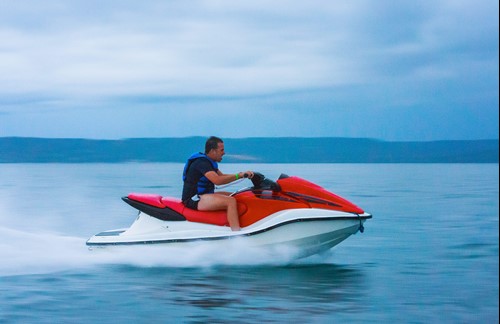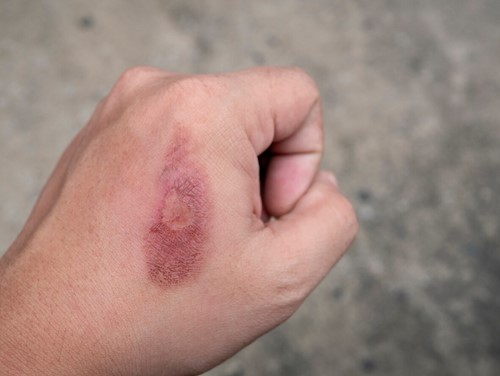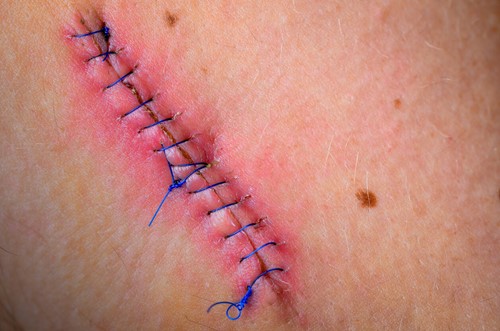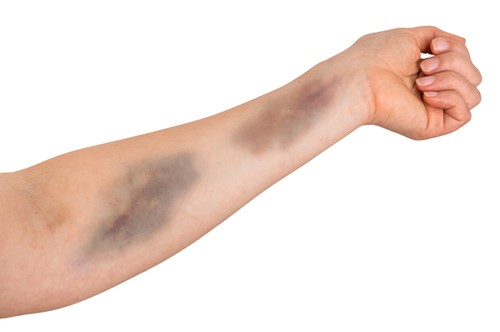Although it’s one of the most fun and exhilarating sports around, jet skiing also comes with a greater risk of injury than most.
Even the slowest jet skis can reach speeds of up to 40mph, so they’re not to be taken lightly.
The causes of jet ski accidents and injuries are similar to those associated with road accidents. Some of the most common causes include:
- Young or inexperienced drivers
- Speeding or reckless driving
- Loss of control
- Lack of concentration
- Inadequate safety gear
- Driving under the influence of alcohol or drugs
The good news is, these accidents can be avoided if you take the right preventative steps. Whether you’re the driver or passenger, you can do your bit to make sure you and those around you remain safe and injury-free.
That’s where we come in. Here are 7 common jet ski injuries and how you can avoid them.
1. Whiplash

Whiplash normally occurs when a sudden, unexpected movement jerks your body too quickly for you to react.
You can suffer from whiplash pretty much anywhere with high speeds involved, which makes it one of the most common jet ski injuries.
The most common symptoms of whiplash are headaches, neck pain and stiffness. In more severe cases, you could experience blurred vision, bleeding in the ears, and even the inability to move your head from side to side.
How to avoid whiplash on a jet ski
To avoid whiplash while jet skiing, you need to pay close attention to the throttle before you accelerate.
If you pull on the throttle too quickly, your body will jolt forward and put you at risk of a neck injury.
Another way of avoiding whiplash is to not turn your jet ski too quickly. You should try to take slower, wider turns – especially if you’re a beginner.
Related: What Is Whiplash And How Can You Avoid It?
2. Breaks, fractures, and sprains
Bad collisions on a jet ski can cause equally bad injuries such as breaks, fractures, and sprains.
While a fracture isn’t as bad as a complete break, anyone that’s suffered one will tell you they’re extremely painful and can take weeks, sometimes months, to heal.
Another injury linked closely to a break or fracture is a sprain. Sprains happen when the tendons between your bones are overstretched or damaged.
On a jet ski, sprains are most common in your arms, shoulders, and wrists. This injury occurs when you accelerate too quickly, as the sudden jolt forward – combined with your tight handle grip – can put pressure on the aforementioned areas of the body.
How to avoid breaks, fractures, and sprains on a jet ski
The most important thing you can do to prevent a break, fracture, or sprain is to watch your speed.
Maintaining a sensible speed makes collisions (and thus their resulting injuries) far less likely.
3. Friction burns

Friction burns happen when your skin rubs quickly against something. In the context of a jet ski, this ‘something’ is often a piece of rope or sometimes the handles.
Although not usually too serious and quite easy to treat with a basic first-aid kit, friction burns can become infected and nasty if not addressed promptly.
How to avoid friction burns on a jet ski
One of the most effective ways of avoiding a friction burn is to wear riding gloves while you’re out on the water. Gloves protect your hands and fingers from burns and blisters, and they have the added bonus of providing extra grip on the handles.
Burns can happen on your legs, too. So, you may want to consider whether a pair of light, waterproof trousers would be a better option than shorts.
If you’re unfortunate enough to suffer a burn, the best way to treat it is by placing it under cold, running water for ten to 15 minutes and apply anti-inflammatory cream once dry.
Friction burns are a perfect example of why you should always have a first-aid kit on board your jet ski.
Related: 10 Best Jet Ski Riding Gloves Of 2021
4. Lacerations

A laceration is a wound that occurs when there’s a tear in your soft body tissue or muscle. In fact, you could consider them a ‘step up’ from a friction burn in terms of severity.
Lacerations are incredibly painful and not nice to look at. They’re often jagged and irregular in shape and are prone to further contamination and infection via bacteria and various other debris.
How to avoid lacerations on a jet ski
Lacerations can occur anywhere on the body, so wearing protective gear on the water is essential if you want to avoid them.
Personal floatation devices (PFDs) can protect your chest and abdomen from lacerations. Besides this, lacerations can normally be avoided in the same way that friction burns are.
Related: The 5 Different Types Of Personal Flotation Devices
5. Concussion
A blow to the head causes a concussion injury, but a concussed person often might not realise the severity of their injury at first, or at least until symptoms begin to show.
Symptoms of concussion include headaches, dizziness, nausea, memory loss, confusion, and blurred vision. If not recognised and treated accordingly, a concussion can lead to other problems like drowning.
Concussions range from mild to serious and are often come from riders not wearing the right protective headwear. If a rider is thrown off the jet ski at speed, they’ll hit the water or other obstacles hard and could become concussed.
How to avoid concussion on a jet ski
Wearing protective, padded headgear is the best and simplest way to avoid concussions.
You should also regulate your speed to minimise the landing impact if you come off your jet ski with force.
Related: 10 Best Ways To Avoid A Concussion
6. Bruising

We don’t need to go into too much detail about bruises – we’ve all had them.
Bruises normally occur when your body is impacted by another object, i.e., another person or jet ski.
But perhaps a not-so-obvious cause of bruising on a jet ski is when you’re travelling at speed and repeatedly bobbing out of the water. Liken it to when a car goes over a pothole; this will cause your jet ski to bump into your bottom half and may leave bruises.
How to avoid bruising on a jet ski
To avoid bruising whilst on your jet ski, you should again control your speed and always be aware of your surroundings.
7. Spinal cord injuries

Spinal cord injuries are very serious, and it’s not uncommon for some jet skiers to end up completely paralysed in the worst-case scenarios.
Riders are most at risk of injuring their spine in adverse weather conditions when the waters are particularly choppy. Injuries are normally caused when a rider is thrown off the jet with force and hits the water at speed.
If you have a spinal cord injury, you need to seek immediate medical attention.
How to avoid spinal injuries on a jet ski
Spinal cord injuries are a prime example of why having a dedicated ‘spotter’ is always recommended when you’re out on your jet ski.
If you’re injured and physically unable to move, you need to have somebody close by that can come to your aid.
They may not be able to prevent the injury itself, but the severity of your injury can certainly be lessened if you act quickly.
If you’d rather ‘play it safe’, then don’t venture out in stormy weather or on choppy waters.
Related: What is spinal cord injury?
Specialist jet ski insurance from Insure4Boats
Regardless of how careful you are on your jet ski and how clued up you are on injury prevention, the extreme nature of jet skiing means that accidents and injuries are always a risk.
That’s why you need to make sure you have insurance – not just to protect you, but your jet ski, too.
Our specialist jet ski insurance policies are designed to cover you against theft, loss, and damage up to the value of £20,000.
We also offer third party liability up to £1m, which protects you should you be responsible for injuries to others and damage to other jet skis. Therefore, you can spend less time worrying and more time out on the water.
Click on the button below to learn more about how we can help and get an instant online quote today.
Related
10 Must-Have Jet Ski Accessories
The 5 Best Jet Ski Locations In The UK
8 Reasons Why You Should Buy A Jet Ski
Please note the information provided on this page should not be taken as advice and has been written as a matter of opinion. For more on insurance cover and policy wording, see our homepage.


